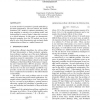Free Online Productivity Tools
i2Speak
i2Symbol
i2OCR
iTex2Img
iWeb2Print
iWeb2Shot
i2Type
iPdf2Split
iPdf2Merge
i2Bopomofo
i2Arabic
i2Style
i2Image
i2PDF
iLatex2Rtf
Sci2ools
WSC
1997
1997
An Integrated Framework for Deterministic and Stochastic Optimization
In recent articles we presented a general methodology for finite optimization. The new method, the Nested Partitions (NP) method, combines partitioning, random sampling, a selection of a promising index, and backtracking to create a Markov chain that converges to a global optimum. In this paper we demonstrate, through examples, how the NP method can be applied to solve both deterministic and stochastic finite optimization problems in a unified framework.
Modeling And Simulation | NP Method | Stochastic finite Optimization | WSC 1997 | finite Optimization |
| Added | 01 Nov 2010 |
| Updated | 01 Nov 2010 |
| Type | Conference |
| Year | 1997 |
| Where | WSC |
| Authors | Leyuan Shi, Sigurdur Ólafsson |
Comments (0)

